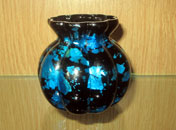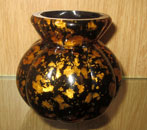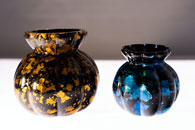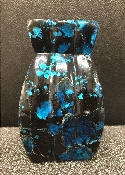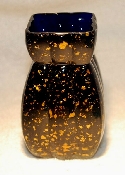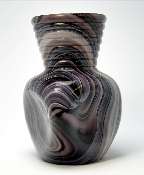Sowerby Nugget Glass
Sowerby 'nugget' is a mould blown, cased, glass with mica inclusions. There are two types of 'nugget', blue and gold. Blue nugget has an outer layer of transparent blue glass over the mica flakes and gold nugget a layer of transparent amber. The picture below also shows a pressed, rather than mould blown, transparent blue tub with mica inclusions.
Picture from Simon Cottle's book 'Sowerby, Gateshead Glass' showing some of the pieces of nugget glass in the Laing Art Gallery, Newcastle.
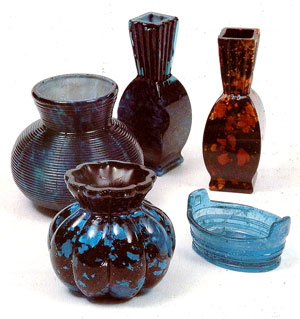
There are few references to Nugget glass in the standard pressed glass texts;
Cottle, (Page 58) Both Gold and Blue Nugget glass, produced in 1883 by the introduction of sheets of cadmium to the glass metal, belies the fanciful story passed down by generations of former Sowerby glassmakers that the nuggets were formed from handfuls of gold sovereigns occasionally thrown by J.G. Sowerby into the pots of molten amber glass.
Murray, (Page 22) Some of the vases described in Catalogues VIII and IX (already mentioned) were made in blue and black using small pieces of silver or gold paper in their manufacture, the wares being called 'Nugget Ware'. Examples can be seen in the Laing Art Gallery, Newcastle upon Tyne, along with other desirable wares of that time which were cased or decorated small vases.
Slack, (Page 40) By January 1880 it appears that Sowerby's were having great success with their more striking colours, including Malachite; and an 'Aesthetic Green' was advertised extensively during the 1880s along with a very pleasant yellow called Giallo. Other colours included Gold and Blue Nugget.
Hajdamach, (Page 307) Other variations were called Spangled glass by the Hobbs, Brockunier company in the United States; Blue Nugget, a type of spangled glass made by Sowerby, and Spatterglass by J.S. Irwin in Pennsylvania.
Assuming the authors of the above references have researched all the contemporary trade publications or advertisements for references to nugget glass,
then references to this type of glass are very sparce. The only reference to the date it was introduced is from Cottle who gives this date as 1883, which may have been an educated guess assuming it was being made about the same time as tortoiseshell glass, for which there is a reference on the cover of the 1882 Sowerby pattern book.
Nugget is a cased glass with the flecks being trapped between two layers of glass then blown into a mould. Like tortoiseshell glass it requires more skill and time from the glassmakers to make this kind of glass.
The shiny inclusions are not cadmium, silver, gold paper, or indeed gold sovereigns, the inclusions are flakes of mica. While Venetian glassmakers had been using metal inclusions, Avventurina (Aventurine in English), for a number of years, Sowerby was one of the first manufacturers to use mica flakes at this date.
Pictured above are two examples of nugget glass, one blue the other gold, similar to the one in the Cottle picture. Both are from my collection.
I bought the gold vase above from America thinking it was a piece of Sowerby gold nugget glass. It was the same shape as the one in the Laing Art Gallery, which is the one in Cottle's picture. In the Tyne & Wear Archives & Museums collection G4972 is 'a Vase of blue nugget pressed glass, globular and lobed, resembling a pumpkin with an everted and lobed neck with a height of 7.8cm and a width of 8.6cm. This is the same height and width as the gold vase from America, so I assumed that the American vase was gold nugget.
Then I bought the blue vase thinking it was the same as the gold piece only to discover they are different.
The blue vase is smaller than the gold vase, 7.5cm tall compared to 8.6cm. The gold vase has thicker walls and, even though it is larger, is much heavier. The gold vase has a dark blue translucent inner casing whereas the blue vase has an opaque black casing, like the one in the Cottle picture. Both have the same ground off top, a feature on other Sowerby mould blown glass.
Hobbs, Brockunier & Company
As referenced in Hajdamach above, 'Other variations were called Spangled glass by the Hobbs, Brockunier company in the United States'. Hobbs, Brockunier were an American company based in Wheeling, West Virginia. Like Sowerby their products were mostly pressed and blown tableware, also like Sowerby by 1880 they were a large, well-established company, responsible for many innovations in glass and glass colours and exporting these products worldwide. J.H.Hobbs, Brockunier and Company on Wikipedia
In November 1883 works superintendent William Leighton Jr. took out a patent Design for Glassware, some of the text of which reads 'a piece of glassware embodying my design, the leading feature of which is an ornamentation composed of a series of spangles or flakes which are incorporated in the body of the glass between inner and outer layers thereof, so as to be visible through the latter'.
In January 1884 a further patent was taken out Manufacture of Spangled Glassware, which is an 'improvement' to the previous patent with more information about how this type of glass is made. Hobbs & Brockunier called this type of glass Spangle Glass.
Examples of Hobbs & Brockunier spangle glass can be found on the Early American Pattern Glass Society website.
The first picture on the page of a 'pumpkin' vase in blue, confirms that my gold nugget was not by Sowerby but Spangle Glass made by Hobbs & Brockunier.
So who copied whom?
Assuming that the blue nugget in the Laing Art Gallery is by Sowerby, it means that Sowerby produced the same pattern in two different sizes. Unfortunately the Sowerby 'Pumpkin' vase does not appear in any of the known pattern books, so it is difficult to put a date on it's production.
We do know from The Peacock and the Lions, Pg 16, that George Sowerby, (J.G. Sowerby's cousin) visited America in 1880 on behalf of the Sowerby company with as many as 2000 items of glass for display (to American companies). Perhaps examples of the new nugget glass were included in this visit and were later copied. The Sowerby and Hobbs patterns are so similar that it is very likely that one is a copy of the other.
The Hobbs & Brockunier patents mentioned above were taken out in 1883 and 1884, their production of this type of glass presumably started at this time. So it is possible that Sowerby were making their nugget glass before Hobbs & Brockunier.
More reasons to believe that Hobbs & Brockunier may have copied Sowerby pieces.
A search at the Tyne & Wear Archives & Museums website for Sowerby nugget glass, finds the piece, [TWCMS:H846] shown in the first picture above.
The second picture shows a piece of glass sold in America as Hobbs & Brockunier in 2020. This is exactly the same shape and size as the Sowerby piece in the first picture. Like the Hobbs & Brockunier pumpkin glass above, the glass in the second picture has the same dark blue translucent glass interior.
The third picture shows a piece of blown purple malachite from my collection which has a a Sowerby mark. Pictures on the Early American Pattern Glass Society website show Spangle Glass vases and jugs which bear a remarkable similarity to this Sowerby malachite vase.
Unfortunately like the Sowerby 'Pumpkin', these two shapes do not appear in any of the known Sowerby pattern books, so again, it is difficult to say exactly when they were made.
It may be that Hobbs & Brockunier copied a few of their earlier pieces from Sowerby and later went on to produce some really nice designs of their own. Production of Spangle glass seems to have ceased around 1887.
Tyne & Wear Archives & Museums use the name 'Nugget Glass' but this name does not appear in advertisements or pattern books. Sowerby produced their small, coloured 'fancy' designs from 1877. By 1885 they had mostly ceased this type of glass and returned to the production of flint glass domestic goods. It can be assumed that due to the small numbers produced, nugget glass, like Sowerby tortoiseshell, was only produced for a short time.
The Tyne & Wear Archives & Museums hold eleven pieces of nugget glass in their collections.
I am still looking for a piece of Sowerby Gold Nugget glass.

